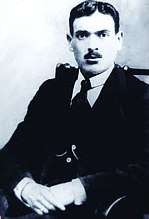Şəmkir
Coordinates: 40°49′47″N 46°01′08″E / 40.82972°N 46.01889°E
| Shamkir Şəmkir | |
|---|---|
 Shamkir | |
| Coordinates: 40°49′47″N 46°01′08″E / 40.82972°N 46.01889°E | |
| Country |
|
| District | Shamkir |
| Established | 1944 |
| Elevation | 450 m (1,480 ft) |
| Population (2010)[1] | |
| • Total | 67,200 |
| Time zone | AZT (UTC+4) |
| • Summer (DST) | AZT (UTC+5) |
| Area code(s) | +994 241 |
| Website | Official website |
Şəmkir is a city in and the capital of Shamkir District in western Azerbaijan, located in the northern foothills of the Lesser Caucasus, on the coast of the Chagirchay River on Tbilisi-Yevlakh highway, about 4 kilometers (2.5 mi) from Dallar railway station. It is the eighth largest city in Azerbaijan by population.
Etymology
One theory is that the name derives from the dialectal Azerbaijani word sham, meaning a place covered in green.[2][3]
History

The historical Shamkur (also known as Shamkhor and Shamkir[2]) has been known since the 5th century as a merchant and craft center of Persia.[3] In 652, the city was seized by Arabs.[4] In 737, Khazars settled in Shamkir after the Arabian commander Mervan's campaign to the Volga.[4] In 752, the city was destroyed by the Sabir people, who lived nearby and rebelled against the Arabs.[4] In 854, the Muslim Khazars took refuge in Shamkir.[4] Later, the city was under the reign of Ganja amirs from the Kurdish dynasty of Shaddadids.[4] In the 12th century and in the beginning of the 13th century, Shamkir was under the Georgian reign.[4] In 1195, the Georgian Queen Tamar's commanders destroyed the troops of Azerbaijan's Atabey Abu-Bakr, who was from Seljuk dynasty of the Ildegizids.[4] In 1235, Shamkir was destroyed by Mongols.[4] From the first quarter of the 16th century till the beginning of the 19th century Shamkir was governed by hereditary rulers of Azerbaijani (Qizilbash) tribe called Shamsaddinli-Zulgadar.[4] In 1803, during the military actions against Ganja khanate, Shamkir was taken up by Russian troops and annexed to Russia.[4]
In 1817–1818, colony of Germans resettled from Wurttemberg, was established on the site of Shamkir under the name Annenfeld.[2] On September 3, 1826, during the Russo-Iran war, Shakh's guard consisting of 10,000 soldiers was destroyed near Annenfeld.[4]

Following World War I, Annenfeld was given the Russian name of Annino (Russian: Аннино).[2] In 1938, it was granted urban-type settlement and renamed Shamkhor (Шамхор), after the nearby railway station and the historical Shamkir.[2][3] In 1944, it was granted town status.[3] In 1991, the name was changed to Shamkir.[2]
Economy
There are cognac and wine plants and also a plant of local industry functioning in the city.
Transportation
Public transport
Shamkir has a large urban transport system, mostly managed by the Ministry of Transportation.
Sports
The city has one professional football team, Shamkir, currently competing in the second-flight of Azerbaijani football, the Azerbaijan First Division.[5] The club has two Azerbaijani league titles.
As of 2014, city's home of Shamkir Chess a category 22 event and one of the highest rated tournaments of all time.[6]
Notable people
Some of the city's many prestigious residents include: poets Molla Vali Vidadi and Ahmad Javad, footballer Javid Imamverdiyev and archer Zinyat Valiyeva.
- Molla Vali Vidadi's poetry expressed positive view on life.
 Ahmad Javad, is known for writings lyrics of Azerbaijan national anthem
Ahmad Javad, is known for writings lyrics of Azerbaijan national anthem Javid Imamverdiyev, footballer.
Javid Imamverdiyev, footballer.
Twin towns and Sister cities
Shamkir is twinned with:
References
Notes
- ↑ The state statistical committee of the Azerbaijan Republic
- 1 2 3 4 5 6 Pospelov, pp. 27–28
- 1 2 3 4 Kotlyakov, entry on "Shamkir"
- 1 2 3 4 5 6 7 8 9 10 11 Soviet Historical Encyclopedia, entry on "Shamkhor" (Russian)
- ↑ ФК "Шамкир" возвращается в профессиональный футбол (in Russian). Retrieved 19 August 2011.
- ↑ "Carlsen beats Nakamura for perfect 2/2 start in the Gashimov Memorial". www.theweekinchess.com. Retrieved 24 April 2014.
- ↑ "Azerbaijan`s Shamkir, Lithuania`s Siauliai to become sister cities". azertag.az. Retrieved February 10, 2015.
Sources
- Е. М. Поспелов (Ye. M. Pospelov). "Имена городов: вчера и сегодня (1917–1992). Топонимический словарь." (City Names: Yesterday and Today (1917–1992). Toponymic Dictionary.) Москва, "Русские словари", 1993.
- "Словарь современных географических названий" (Dictionary of Modern Geographic Names). Под. ред. В. М. Котлякова (ed. V. M. Kotlyakov), 2006.
- "Советская историческая энциклопедия" (Soviet Historical Encyclopedia). Под ред. Е. М. Жукова (ed. Ye. M. Zhukov), 1973–1982.
.svg.png)